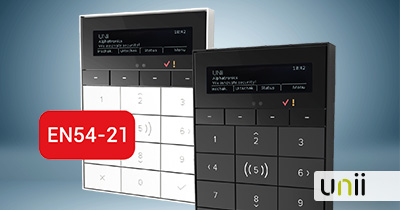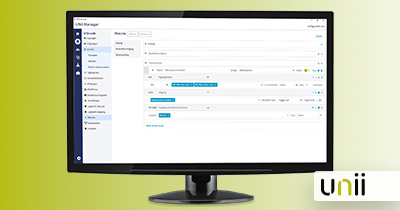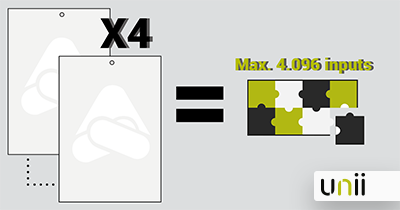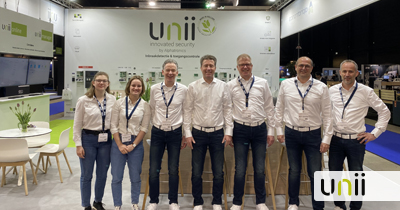The common situation is that the fire alarm control center (BMC) has its own forwarding to the PAC, while the intrusion system, which often hangs next to it, also forwards to the same PAC via a dialer.
The BMC has its own (separate) transmitter and reports to the PAC the three most important reports: fire, hand fire or malfunction. Unlike an intrusion system, we are used to passing detailed detection information to the PAC.
As the first and only burglar alarm system in the market, the UNii is EN54-21 certified to also forward fire alarms to the PAC. This saves an additional transfer carrier as well as a subscription to the control room. EN54-21 pass-through notification is available for the UNii 32, 128 and 512.
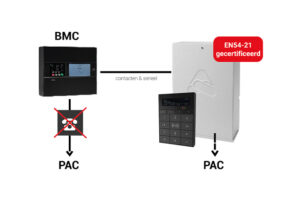
Supplies
What do you need for certified call forwarding
- At least one UNii EN54-21 keypad
- NTC adapter, a temperature sensor that monitors battery temperature (included with keypad)
- UNii 4G module (required by regulations, CAUTION! UNii GPRS communicator is NOT approved)
- EN54-21 one-time license (Item No. 004608, can be activated via UNii manager/UNii online)
- Primary connection between the BMC and the UNii based on contacts
- Optional: serial RS232 connection between BMC and UNii. This requires one RS-232 expansion board
Note that if any of the above supplies 1-5 are missing, the forwarding is not certified.
How does it work?
Forwarding can be performed via two paths:
- Liaison between BMC and UNii based on contacts.
- Serial connection between BMC and UNii
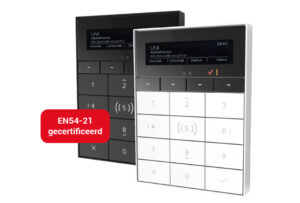
Liaison between BMC and UNii based on contacts.
This is the primary and certified connection. The alarm contacts normally associated with the separate transfer carrier are connected to inputs of the UNii. These include at least the reports: fire, hand fire and malfunctions. These inputs are programmed as such and thus enter the PAC as such.
The intrusion system reports through detailed (as usual) and fire reports through just as the BMC was connected to its own transmitter: fire, hand fire and faults.
This saves an additional transmitter as well as a subscription to the control room.
Serial connection between BMC and UNii.
A second connection will be added. This is the secondary connection, which is complementary to the primary connection. So the primary connection is always needed, it is EN54-21 certified!
The serial secondary connection is an RS232 connection between the BMC and UNii and its purpose is to send along detailed detector information to the PAC. This way, it is not only clear that there is a fire alarm, but also which detectors have been activated. The serial link supports ESPA and Protec protocols. Because this connection is additional, we can add protocols here without the need for recertification.
So you always need the primary connection (the connection between BMC and UNii based on contacts) and on top of that, as an extra, you can realize a secondary RS232 connection for additional detector information.
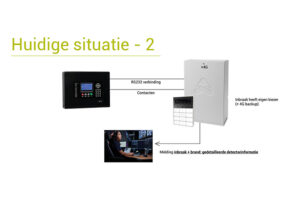
Features and specs
The UNii EN54-21 keypad with reader features two symbols.
The symbols indicate communication to the monitoring station and whether the forwarding was successful. Because regulations require that it must be visible whether a forwarding was successful, you must implement one of the keypads in a project as an EN54-21 keypad.
The EN54-21 keypads are available with reader in 2 colors:
- White (art.no. 004724)
- Black (art.no. 004726)
An existing UNii keypad cannot be converted to an EN54-21 keypad. Furthermore, the EN54-21 keypad is similar to any other UNii keypad.
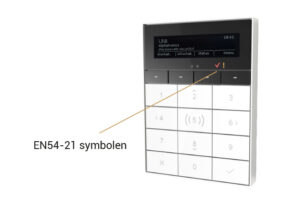
NTC adapter
The NTC adapter is a temperature sensor that monitors the temperature of the battery. This adapter comes with an EN54-21 keypad and is not available separately.
The NTC adapter can be connected to the main board with the first UNii, delivered from November 2019.
Battery duration
What must the battery duration comply with?The applicable standard is EN54-14 (6.8.3) and it describes what the standby time must comply with.
The regulations state:
- well forwarding to PAC: 24h standby time
- No forwarding to PAC: 72h standby time.
More information?
Are you interested in learning more? For example, how to connect the NTC adapter, please watch the webinar back in our e-learning.
In addition, we also have an installation manual available.


